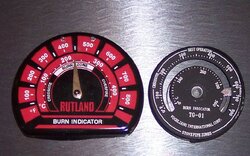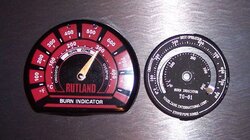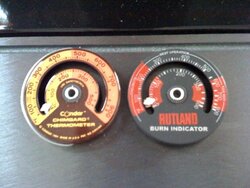Hey All,
I finally got my rear wall protection installed and got to light my new Vermont Castings 2550. I have a couple of questions now that I can finally play with it. Some basic info. Encore 2550 cat, 3 ft DVL rise to 90 elbow and 1 ft horizontal DVL into 16 ft of 8 inch oval dura-liner. Mix of Oak, Walnut, and Hickory @ about 21 percent moisture.
1. How long should the flame keep burning when the air supply is turned all the way down after the cat is engaged?
2. What are some acceptable stove top temperatures with the air supply turned all the way down? During the first couple of hours after the cat is engaged my magnetic stick-on says about 800 degrees on the silver lid. It may be off because my infrared thermometer shows about 500 right behind the silver lid and in the 480's in front of it. For some reason I get a real low (300's) reading on the infrared when I use it on the shiny silver lid. The sides are about 350 and the rear heat shield is about 170.
I really don't think the stove is running too hot, but the magnetic thermometer makes me nervous. My 12X13X8 ft living room is a comfortable 84 and the adjacent rooms are mid 70's. Is there any adjustment to the air shutter to make the stove burn cooler?
I'll post a picture after I get a little clean up done.
Thanks
I finally got my rear wall protection installed and got to light my new Vermont Castings 2550. I have a couple of questions now that I can finally play with it. Some basic info. Encore 2550 cat, 3 ft DVL rise to 90 elbow and 1 ft horizontal DVL into 16 ft of 8 inch oval dura-liner. Mix of Oak, Walnut, and Hickory @ about 21 percent moisture.
1. How long should the flame keep burning when the air supply is turned all the way down after the cat is engaged?
2. What are some acceptable stove top temperatures with the air supply turned all the way down? During the first couple of hours after the cat is engaged my magnetic stick-on says about 800 degrees on the silver lid. It may be off because my infrared thermometer shows about 500 right behind the silver lid and in the 480's in front of it. For some reason I get a real low (300's) reading on the infrared when I use it on the shiny silver lid. The sides are about 350 and the rear heat shield is about 170.
I really don't think the stove is running too hot, but the magnetic thermometer makes me nervous. My 12X13X8 ft living room is a comfortable 84 and the adjacent rooms are mid 70's. Is there any adjustment to the air shutter to make the stove burn cooler?
I'll post a picture after I get a little clean up done.
Thanks




 ).
).